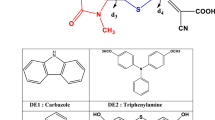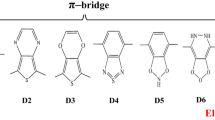Abstract
Reactive dyes exhibit suitable opto-electronic properties, making them promising for dye-sensitized solar cell (DSSC) applications. The present study uses reactive orange 16 dye to design an efficient dye sensitizer for DSSC application using a donor–π–acceptor concept. The sensitizer structures and their electronic and optical properties were investigated using density functional theory (DFT) and time-dependent DFT (TD-DFT) calculations. The molecular electrostatic potential maps, HOMO–LUMO distributions, and density of states plots were obtained for the optimized geometry. The analysis showed that the electronic properties of reactive orange 16 are enhanced due to the π-linkage, responsible for extending the conjugation length of the system. The TD-DFT calculations showed a bathochromic shift in the absorption spectra due to the introduction of the π-linker. The shift confirmed the conjugation's role in enhancing the sensitizers' electronic properties. The transitions were π \(\to\) π* and n \(\to\) π*, and the transition with maximum oscillator strength was assigned to the H → L excitation. The study showed that donor–π–acceptor concept-based sensitizers derived from reactive dyes favor DSSC applications. Hence, this study's findings could be used to design and develop more efficient dye sensitizers based on reactive dyes.






Similar content being viewed by others
Data availability
The authors confirm that this article contains all the data supporting the findings of this study.
References
Iqbal, M.Z., Ali, S.R., Khan, S.: Progress in dye sensitized solar cell by incorporating natural photosensitizers. Sol. Energy 181, 490–509 (2019). https://doi.org/10.1016/j.solener.2019.02.023
Sharma, K., Sharma, V., Sharma, S.S.: Dye-sensitized solar cells: fundamentals and current status. Nanoscale Res. Lett. 13, 381 (2018). https://doi.org/10.1186/s11671-018-2760-6
Mingsukang, M.A., Buraidah, M.H., Arof, A.K.: Third-Generation-Sensitized Solar Cells. In: Nanostructured Solar Cells. InTech (2017)
Fujishima, A., Honda, K.: Electrochemical photolysis of water at a semiconductor electrode. Nature 238, 37–38 (1972). https://doi.org/10.1038/238037a0
O’Regan, B., Grätzel, M.: A low-cost, high-efficiency solar cell based on dye-sensitized colloidal TiO2 films. Nature 353, 737–740 (1991). https://doi.org/10.1038/353737a0
Yella, A., Lee, H.-W., Tsao, H.N., Yi, C., Chandiran, A.K., Nazeeruddin, M.K., Diau, E.W.-G., Yeh, C.-Y., Zakeeruddin, S.M., Grätzel, M.: Porphyrin-sensitized solar cells with cobalt (II/III)–based redox electrolyte exceed 12 percent efficiency. Science 80(334), 629–634 (2011). https://doi.org/10.1126/science.1209688
Mathew, S., Yella, A., Gao, P., Humphry-Baker, R., Curchod, B.F.E., Ashari-Astani, N., Tavernelli, I., Rothlisberger, U., Nazeeruddin, M.K., Grätzel, M.: Dye-sensitized solar cells with 13% efficiency achieved through the molecular engineering of porphyrin sensitizers. Nat. Chem. 6, 242–247 (2014). https://doi.org/10.1038/nchem.1861
Boschloo, G.: Improving the performance of dye-sensitized solar cells. Front. Chem. 7, 77 (2019). https://doi.org/10.3389/fchem.2019.00077
Hafez, H.S., Shenouda, S.S., Fadel, M.: Photovoltaic characteristics of natural light harvesting dye sensitized solar cells. Spectrochim. Acta Part A Mol. Biomol. Spectrosc. 192, 23–26 (2018). https://doi.org/10.1016/j.saa.2017.10.066
Devadiga, D., Selvakumar, M., Shetty, P., Santosh, M., Chandrabose, R.S., Karazhanov, S.: Recent developments in metal-free organic sensitizers derived from carbazole, triphenylamine, and phenothiazine for dye-sensitized solar cells. Int. J. Energy Res. 45, 6584–6643 (2021). https://doi.org/10.1002/er.6348
Naik, P., Su, R., Elmorsy, M.R., El-Shafei, A., Adhikari, A.V.: Investigation of new carbazole based metal-free dyes as active photo-sensitizers/co-sensitizers for DSSCs. Dye. Pigment. 149, 177–187 (2018). https://doi.org/10.1016/j.dyepig.2017.09.068
Louis, H., Onyebuenyi, I.B., Odey, J.O., Igbalagh, A.T., Mbonu, M.T., Eno, E.A., Pembere, A.M.S., Offiong, O.E.: Synthesis, characterization, and theoretical studies of the photovoltaic properties of novel reactive azonitrobenzaldehyde derivatives. RSC Adv. 11, 28433–28446 (2021). https://doi.org/10.1039/D1RA05075C
Ji, J.-M., Zhou, H., Kim, H.K.: Rational design criteria for D–π–A structured organic and porphyrin sensitizers for highly efficient dye-sensitized solar cells. J. Mater. Chem. A. 6, 14518–14545 (2018). https://doi.org/10.1039/C8TA02281J
Pashaei, B., Shahroosvand, H., Graetzel, M., Nazeeruddin, M.K.: Influence of ancillary ligands in dye-sensitized solar cells. Chem. Rev. 116, 9485–9564 (2016). https://doi.org/10.1021/acs.chemrev.5b00621
Lee, C.-P., Li, C.-T., Ho, K.-C.: Use of organic materials in dye-sensitized solar cells. Mater. Today 20, 267–283 (2017). https://doi.org/10.1016/j.mattod.2017.01.012
Kacimi, R., Raftani, M., Abram, T., Azaid, A., Ziyat, H., Bejjit, L., Bennani, M.N., Bouachrine, M.: Theoretical design of D-π-A system new dyes candidate for DSSC application. Heliyon 7, e07171 (2021). https://doi.org/10.1016/j.heliyon.2021.e07171
Singh, S.P., Roy, M.S., Thomas, A., Bhanuprakash, K., Sharma, G.D.: Effect of linker used in D-A–π–A metal free dyes with different π-spacers for dye sensitized solar cells. Org. Electron. 13, 3108–3117 (2012). https://doi.org/10.1016/j.orgel.2012.05.013
Arslan, B.S., Güzel, E., Kaya, T., Durmaz, V., Keskin, M., Avcı, D., Nebioğlu, M., Şişman, İ: Novel D-π-A organic dyes for DSSCs based on dibenzo[b, h][1,6]naphthyridine as a π-bridge. Dye. Pigment. 164, 188–197 (2019). https://doi.org/10.1016/j.dyepig.2019.01.027
Barati-darband, F., Izadyar, M., Arkan, F.: Anchoring group and π-spacer effects on the dynamics and kinetics of the photovoltaic processes in the quinoxaline-based organic dye-sensitized solar cells. J. Phys. Chem. C 122, 23968–23977 (2018). https://doi.org/10.1021/acs.jpcc.8b07965
Tan, C.-J., Yang, C.-S., Sheng, Y.-C., Amini, H.W., Tsai, H.-H.G.: Spacer effects of donor-π spacer-acceptor sensitizers on photophysical properties in dye-sensitized solar cells. J. Phys. Chem. C 120, 21272–21284 (2016). https://doi.org/10.1021/acs.jpcc.6b07032
Mao, J., Guo, F., Ying, W., Wu, W., Li, J., Hua, J.: Benzotriazole-bridged sensitizers containing a furan moiety for dye-sensitized solar cells with high open-circuit voltage performance. Chem.- Asian J. 7, 982–991 (2012). https://doi.org/10.1002/asia.201100967
Tian, H., Yang, X., Pan, J., Chen, R., Liu, M., Zhang, Q., Hagfeldt, A., Sun, L.: A triphenylamine dye model for the study of intramolecular energy transfer and charge transfer in dye-sensitized solar cells. Adv. Funct. Mater. 18, 3461–3468 (2008). https://doi.org/10.1002/adfm.200800516
Yin, N., Wang, L., Lin, Y., Yi, J., Yan, L., Dou, J., Yang, H.-B., Zhao, X., Ma, C.-Q.: Effect of the π-conjugation length on the properties and photovoltaic performance of A–π–D–π–A type oligothiophenes with a 4,8-bis(thienyl)benzo[1,2- b :4,5- b ′]dithiophene core. Beilstein J. Org. Chem. 12, 1788–1797 (2016). https://doi.org/10.3762/bjoc.12.169
Zhang, X., Gou, F., Zhao, D., Shi, J., Gao, H., Zhu, Z., Jing, H.: π-Spacer effect in dithiafulvenyl-π-phenothiazine dyes for dye-sensitized solar cells. J. Power. Sources 324, 484–491 (2016). https://doi.org/10.1016/j.jpowsour.2016.05.120
Yen, Y.-S., Indumathi, V.: Effect of π-conjugated spacer in N-alkylphenoxazine-based sensitizers containing double anchors for dye-sensitized solar cells. Polymers (Basel) 13, 1304 (2021). https://doi.org/10.3390/polym13081304
Dindorkar, S.S., Yadav, A.: Insights from density functional theory on the feasibility of modified reactive dyes as dye sensitizers in dye-sensitized solar cell applications. Solar 2, 12–31 (2022). https://doi.org/10.3390/solar2010002
Wallingford CT: Gaussian, Inc., (2013)
Kjaergaard, H.G., Bezar, K.J., Brooking, K.A.: Calculation of dipole moment functions with density functional theory: application to vibrational band intensities. Mol. Phys. 96, 1125–1138 (1999). https://doi.org/10.1080/00268979909483055
Hanwell, M.D., Curtis, D.E., Lonie, D.C., Vandermeersch, T., Zurek, E., Hutchison, G.R.: Avogadro: an advanced semantic chemical editor, visualization, and analysis platform. J. Cheminform. 4, 17 (2012). https://doi.org/10.1186/1758-2946-4-17
O’Boyle, N.M., Tenderholt, A.L., Langner, K.M.: Cclib: a library for package-independent computational chemistry algorithms. J. Comput. Chem. 29, 839–845 (2008). https://doi.org/10.1002/jcc.20823
Bonyad, S.R., Mirjafary, Z., Saeidian, H., Rouhani, M.: Efficient synthesis, spectroscopic characterization and DFT based studies of novel 1-amide 4-sulfonamide-1,2,3-triazole derivatives. J. Mol. Struct. 1197, 164–170 (2019). https://doi.org/10.1016/j.molstruc.2019.07.032
Lee, G.H., Kim, Y.S.: Theoretical study of effect of introducing π -conjugation on efficiency of dye-sensitized solar cell. J. Nanosci. Nanotechnol. 18, 6640–6644 (2018). https://doi.org/10.1166/jnn.2018.15714
Shimizu, A., Ishizaki, Y., Horiuchi, S., Hirose, T., Matsuda, K., Sato, H., Yoshida, J.: HOMO–LUMO energy-gap tuning of π-conjugated zwitterions composed of electron-donating anion and electron-accepting cation. J. Org. Chem. 86, 770–781 (2021). https://doi.org/10.1021/acs.joc.0c02343
Mukherjee, S., Torres, D.E., Jakubikova, E.: HOMO inversion as a strategy for improving the light-absorption properties of Fe(II) chromophores. Chem. Sci. 8, 8115–8126 (2017). https://doi.org/10.1039/c7sc02926h
Hu, W., Yu, P., Zhang, Z., Shen, W., Li, M., He, R.: Theoretical study of YD2-o-C8-based derivatives as promising sensitizers for dye-sensitized solar cells. J. Mater. Sci. 52, 1235–1245 (2017). https://doi.org/10.1007/s10853-016-0364-z
Acknowledgements
The authors thank Dr B. Ganguly, CSIR–CSMCRI, Bhavnagar, for his help in theoretical calculations. The registration number of this manuscript is 029/2022.
Funding
This research received no external funding.
Author information
Authors and Affiliations
Contributions
A.Y., S.D., and V.P. were involved in conceptualization, methodology, data curation, writing—original draft, visualization, investigation, and writing—review and editing.
Corresponding author
Ethics declarations
Conflict of interest
The authors declare that they have no known competing financial interests or personal relationships that could have appeared to influence the work reported in this paper.
Ethical approval
Not applicable.
Consent for publication
The authors gave their consent to publish the paper in this journal.
Additional information
Publisher's Note
Springer Nature remains neutral with regard to jurisdictional claims in published maps and institutional affiliations.
Rights and permissions
Springer Nature or its licensor (e.g. a society or other partner) holds exclusive rights to this article under a publishing agreement with the author(s) or other rightsholder(s); author self-archiving of the accepted manuscript version of this article is solely governed by the terms of such publishing agreement and applicable law.
About this article
Cite this article
Yadav, A., Dindorkar, S.S. & Patel, V. Untangling the effect of π-conjugation length on the opto-electronic properties of reactive dye-based sensitizer. J Comput Electron 22, 1706–1714 (2023). https://doi.org/10.1007/s10825-023-02101-0
Received:
Accepted:
Published:
Issue Date:
DOI: https://doi.org/10.1007/s10825-023-02101-0




